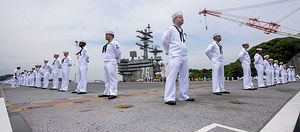The U.S. Navy nuclear-powered Nimitz-class aircraft carrier USS Ronald Reagan has departed Yokosuka naval base in Japan on May 16 to resume operations in the Asia-Pacific region, the U.S. Navy said in a May 16 press statement.
The USS Ronald Reagan’s departure follows last week’s successful completion of sea trials. The carrier was originally scheduled to resume operations on May 15, but the deployment had to be postponed due to an unspecified issue aboard the ship.
“While in port Yokosuka and conducting routine pre-underway checks, a material issue was identified that requires repair,” a May 15 U.S. Navy statement said. “There is no impact to the safety of the aircraft carrier.” The issue appears to have been fixed over the following 24 hours.
“Coming out of a long in-port maintenance period, we have to ensure that Ronald Reagan, CVW 5 [carrier air wing] and the remainder of the strike group are integrated properly as we move forward,” said Rear Admiral Charles Williams. “As our ships’ and our aircrafts’ capabilities evolve, we have to do the same as a strike group.”
The USS Ronald Reagan and its carrier air wing will now begin conducting flight deck and carrier qualifications to certify their ability to safely launch and recover aircraft. “We have to focus on our primary job to re-integrate with our air wing so that they are able to conduct business and carry out our mission,” the commanding officer of the Nimitz-class carrier, Captain Buzz Donnelly, said.
The USS Ronald Reagan is the U.S. Navy’s only forward deployed carrier in the Asia-Pacific region and homeported at Yokosuka Naval Base in Japan’s Kanagawa Prefecture. The ship completed its last patrol cycle on November 21, 2016. As I explained last week:
During the patrol, the carrier participated in a number of exercises including Valiant Shield, Keen Sword, and Invincible Spirit. The respective exercises aimed to enhance joint military operations with allied navies in the region, in particular the Republic of Korea Navy and Japan Maritime Self Defense Force.
The carrier’s escort includes the Ticonderoga-class guided-missile cruiser USS Shiloh; the Arleigh Burke-class guided-missile destroyers USS Barry, USS John S. McCain, USS McCampbell and USS Mustin. Every carrier strike group (CSG) is also accompanied by one or two nuclear-powered fast attack submarines.
The U.S. Navy has not announced any port calls or specified the CSG’s first destination.
The U.S. Navy’s second deployed aircraft carrier in the Asia Pacific region, the USS Carl Vinson, will remain deployed in waters near the Korean Peninsula indefinitely, as tensions between South and North Korea have been heating up.
North Korea recently tested a new intermediate-range ballistic missile (IRBM). The test launch of the Hwasong-12 launch may prove to be a major stepping stone in the North Korean quest to threaten the U.S. mainland with nuclear weapons, I explained yesterday.
The Carl Vinson CSG includes the Nimitz-class aircraft carrier USS Carl Vinson, the Arleigh Burke-class guided-missile destroyers USS Wayne E. Meyer and USS Michael Murphy, and the Ticonderoga-class guided-missile cruiser USS Lake Champlain.
































